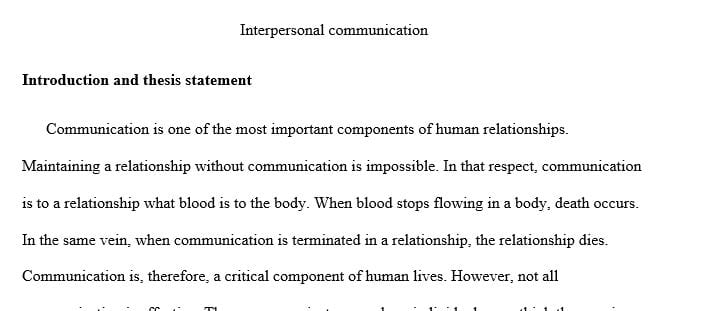Explain the principles of and barriers to effective interpersonal communications.
Read this sample of an exemplary outline
Do the “week two training quiz”.
Use this outline template
Before you begin your paper, you must review the Final Paper instructions in Week Five. You will see that you will be writing a letter of advice for a couple or group of co-workers, using the first five course learning objectives of this course. This assignment is designed to get you to create a preliminary plan for doing that final assignment that will be due in Week Five. For this week’s outline assignment you will focus only on the three learning objectives we’ve already covered in the first two weeks (listed below). Remember though that in the final draft you will be required to cover all five course learning objectives. Here are the learning objectives you must cover in this outline, and some advice for adequately addressing each:
Explain the principles of and barriers to effective interpersonal communications. Be sure to address the significance of each principle in being an effective communicator. The best papers will list at least two barriers and provide advice for overcoming each of them.
Analyze the role of communication in developing and maintaining one’s self-concept, self-image, and self-esteem. Be sure to define each term and directly connect each to communication. The best papers will address the relationship between psychology and communication and the importance of the relationship.
Analyze the impact of gender and culture on interpersonal communications. Explain the relationship between gender, culture and communication and how acknowledging these elements is central to becoming an effective communicator. Consider the pros and cons of what are often deemed more “masculine” versus “feminine” forms of communication and how various styles can help us in particular contexts.
Remember, an outline is not full paragraphs. Instead, it is in bullet point form. However, you must provide a preliminary introduction and conclusion so we can see that you are on the right track. Those are the only places where paragraphs are appropriate. For more help on outlining, please review this information on outlining https://awc.ashford.edu/writing-tools-outline.html) Outline (Links to an external site.) created by the Ashford Writing Center.
The outline must contain
An introduction with thesis statement. For help with the thesis statement specifically, please click here:
Thesis Statements (Links to an external site.)
Introductions and Conclusions (Links to an external site.)
All learning objectives, with details about how you plan to address each. Please be sure to explain how you plan to support all of your key claims from expert sources. For more information about how to do this, watch this video: Integrating Research (Links to an external site.). Though you will not be writing full body paragraphs, with the exception of your introduction and conclusion, you still must give your instructor a sense of how you plan to cover each objective with course materials, independent academic research, and personal experiences that correlate with those key points.
A conclusion. The conclusion should restate the overall perspective offered in the paper, with a restatement of the thesis and the central points outlined in the paper.
A reference page containing at least three academic resources. You should find at least two of these resources independently in the Ashford University Library. To get started, review the following resources. And if you need further assistance, please contact the Ashford University Library.
FindIt@AU Tutorial (Links to an external site.)
Keywords are Critical (Links to an external site.)
Remember, you will need to cite your sources in order to get credit for the use of course and academic materials, which is part of how you will be assessed. Please carefully review the grading rubric so you have a clear sense of how you will be graded. If you are having difficulties understanding any of these instructions, contact your instructor. You will receive feedback on this draft so that you can make the necessary improvements for your Final Paper submission during Week Five.
I need the outline for today. Will let you know when to embark on the final paper.
also here is the final paper requirements
Letter of Advice
For this assignment, you will write a letter of advice to either a newly engaged couple or a group of coworkers. Imagine that either the engaged couple or coworkers hear that you are taking a course in interpersonal communication and want advice regarding how to communicate in their personal or professional relationships. Based on what you have learned in this course, your personal experience, and the five learning objectives we have covered, what advice would you give them regarding how to communicate effectively? How can you use what you have learned in this class to offer a couple or group of co-workers advice to have more positive relationships? Write your paper in the form of a letter. Please review the Sample Final Paper
Instructions
Use the list of learning outcomes to write your letter. The course learning outcomes you will need to cover are listed below:
Explain the principles of and barriers to effective interpersonal communications.
Analyze the role of communication in developing and maintaining one’s self-concept, self-image, and self-esteem.
Differentiate appropriate levels of self-disclosure and emotional intelligence in various relationships.
Describe strategies for using communication techniques to resolve interpersonal conflicts.
Analyze the impact of gender and culture on interpersonal communications.
For each of the five learning outcomes, create a separate heading that states the learning outcome that you are addressing. Then, address the following for each segment:
Explain the principles of and barriers to effective interpersonal communications. Why do the principles matter? How can your couple or group of co-workers overcome the barriers you have listed?
Analyze the role of communication in developing and maintaining one’s self-concept, self-image, and self-esteem. Begin by defining each term and then explain how these three notions of the self potentially impact the relationships of your couple or group of co-workers. What advice can you offer to help them develop a positive self-concept or build each other’s self-esteem?
Illustrate the importance of self-disclosure and emotional intelligence in various relationships. What role does self-disclosure play in the relationships of your couple or co-workers? How can their relationships be improved by them becoming more emotionally intelligent? What connections can be made between emotional intelligence and self-disclosure?
Evaluate strategies for using communication techniques to resolve interpersonal conflicts. Explain one or two potential conflicts and then present at least two strategies for addressing the dispute(s).
Analyze the impact of gender and culture on interpersonal communications. First, define these two key terms. Then, explain the importance of gender and culture in relationships generally and for your couple or group of co-workers specifically. What advice can you give to become a better communicator based on the information you have presented?
Content Requirements
You must address all five of the learning outcomes and the questions listed with those objectives. For each objective, be sure to define key terms and relate those ideas directly to advice for your couple or co-workers. The point here is for you to demonstrate how these ideas can be utilized to help people in their relationships. Try to offer specific advice they can integrate into their lives.
Begin your paper with an introductory paragraph that has a succinct thesis statement and that previews what you plan to cover in your paper. End with a conclusion that reaffirms your thesis and restates your key points.
You must use at least five scholarly sources to help you make your points. At least three of these should be course readings and two should be academic articles you have found yourself by doing research in the Ashford University Library. If you need help doing research, visit the Ashford University Library, which can be accessed through the Library tab in the left-navigation menu, in your online course.
You must also draw on personal experience to offer advice or to illustrate points. It is acceptable to use hypothetical examples and/or your personal experiences for either your couple or group of co-workers. We simply want to see that you can apply what you have learned to some potential “real world” experience.
The Final Paper
Must be 8 to 10 double-spaced pages in length (not including title and references pages) and formatted according to APA style. For assistance, visit the Ashford Writing Center’s APA Essay Checklist for Students (Links to an external site.).
Must include a title page with the following: (For further assistance with the formatting and the title page, please refer to the Formatting Instructions for MS Word 2013 (Links to an external site.))
Title of paper
Student’s name
Course name and number
Instructor’s name
Date submitted
Must include an introduction and conclusion paragraph. Your introduction paragraph needs to end with a clear thesis statement that indicates the purpose of your paper. For assistance on writing Introductions and Conclusions (Links to an external site.) as well as Thesis Statements (Links to an external site.), please refer to the Ashford Writing Center resources.
Must use each learning objectives as a header dividing each section of the paper.
Must use the textbook as a source. The Integrating Research (Links to an external site.) tutorial will offer further assistance on including supporting information and reasoning.
Must use two additional course articles/videos and two academic articles the student has found independently. A total of five sources must be used in the paper and be on the reference list.
Must document any information from a source in APA style, as outlined in the Ashford Writing Center’s In-Text Citation Guide (Links to an external site.).
Must include a separate APA References List (Links to an external site.) that is formatted according to APA style.
Before you submit your written assignment, you are encouraged to review The Grammarly Guide: How to Set Up & Use Grammarly (Links to an external site.)tutorial, set up a Grammarly account (if you have not already done so), and use Grammarly to review a rough draft of your assignment. Then carefully review all issues identified by Grammarly and revise your work as needed.
Final Notes
This is a formal paper and should utilize proper grammar, complete sentences, and paragraph transitions. However, you will write this paper in the format of a letter to the newly-engaged couple or group of co-workers. Feel free to address the people you select directly throughout the paper.
Answer preview to explain the principles of and barriers to effective interpersonal communications.
APA
867 words



